What is art? Who makes art? What is an artist? And who the heck knows what it all means? In 1934 a group of English coal miners in the town of Ashington wanted to know about these questions and more. Out of their own money they chipped in to bring an art professor to teach them about art.
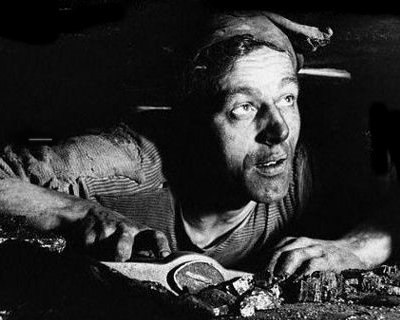 British coal miners in the 1930s made about two pounds and eight shillings a day for ten hours of backbreaking work. Each shift had a different focus. First shift picked at the seams of coal, sometimes crawling on their bellies when the tunnel ceilings got down to only eighteen inches. Second shift did the blasting. Third shift broke it up and shoveled it into tubs. None of these sound appealing.
British coal miners in the 1930s made about two pounds and eight shillings a day for ten hours of backbreaking work. Each shift had a different focus. First shift picked at the seams of coal, sometimes crawling on their bellies when the tunnel ceilings got down to only eighteen inches. Second shift did the blasting. Third shift broke it up and shoveled it into tubs. None of these sound appealing.
In 1934 there were 834 fatalities and more than 30,000 injuries requiring an absence of more than three days of work. The WEA (Worker's Educational Association) was founded in 1903 to further the education of unionized workers. "An inquiring mind is sufficient qualification," was all that was required to take part in the learning process.
The education was part entertainment and part fulfillment.
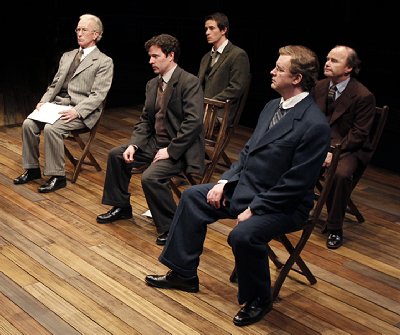 The group that gathered in Ashington met in a room at the YMCA and waited for "Professor" Robert Lyon from Armstrong College. He arrived and began a slide presentation of classical paintings. (Slide shows were the PowerPoint of the day.) The group was dismayed to find out Lyon was not a professor and couldn't answer their questions about what art meant. Lyon tried to explain that the meaning of art comes not only from the art itself, but from the viewer as well. But the miners had never even seen a real painting or been to a gallery in their lives. Lyon proposed that they create their own paintings. Since the WEA rules forbade teaching anything that could be used to earn money, they applied for and received permission to paint.
The group that gathered in Ashington met in a room at the YMCA and waited for "Professor" Robert Lyon from Armstrong College. He arrived and began a slide presentation of classical paintings. (Slide shows were the PowerPoint of the day.) The group was dismayed to find out Lyon was not a professor and couldn't answer their questions about what art meant. Lyon tried to explain that the meaning of art comes not only from the art itself, but from the viewer as well. But the miners had never even seen a real painting or been to a gallery in their lives. Lyon proposed that they create their own paintings. Since the WEA rules forbade teaching anything that could be used to earn money, they applied for and received permission to paint.
"The Pitmen Painters" is based on the real group of Ashington painters. Lyon, played by Frank Layler, taught the group much more than art appreciation. He taught them about the feelings and passion that can be released in art. The group is at times serious and at times funny as the men begin to share their thoughts and their own artwork.
At first they were reluctant and even threw away early attempts as rubbish. It was through the give and take of their mates' comments that they were able to see value in their own work and that of their friends. The shared experience is what art is all about.
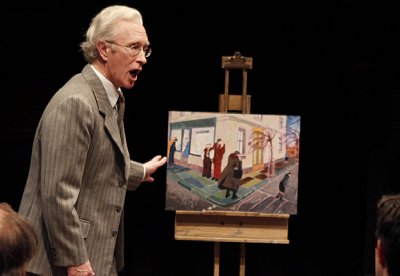 R. Hamilton Wright, last seen in "Mary Stuart" played the dental engineer (he made dentures) Harry Wilson. Harry wasn't a miner; not all the group members were. He had been gassed during the World War I Battle of the Somme, where the British suffered nearly 420,000 casualties and prisoners of war. Harry is a serious man, who shows his art almost apologetically. He doesn't dress as somberly as the other members of the group. He's almost natty.
R. Hamilton Wright, last seen in "Mary Stuart" played the dental engineer (he made dentures) Harry Wilson. Harry wasn't a miner; not all the group members were. He had been gassed during the World War I Battle of the Somme, where the British suffered nearly 420,000 casualties and prisoners of war. Harry is a serious man, who shows his art almost apologetically. He doesn't dress as somberly as the other members of the group. He's almost natty.
When I was a fine art major (painting and drawing) at the University of Puget Sound, the recognition of our fellow art students with the simple comment, "You do good work," meant more than grades or comments from instructors or anyone else. This is what we saw in the production as well. There was no BS; there were arguments and discussion, but no toadying.
Recognition of the quality of their work came fairly soon. People were amazed at their ability. Even the pitmen were amazed at the recognition they received. Being working class men, there was a perception, by them and by their "betters", that art was something for the middle and upper classes. Art is personal, which makes criticism hard to take for some artists, and some of the viewers.
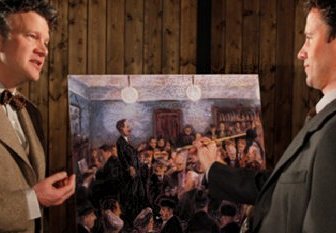 Jason Marr played the most successful of the artists in the production, Oliver Kilbourn. Jason played the artist as extremely sensitive. He understood art. When a patron offered him a stipend of two pounds ten shillings a week, two shillings more than he earned mining, to leave the mines and simply paint whatever he wanted, he declined. He felt peer pressure from the group as well as a feeling that he would suffer a loss from being outside his group of painters. It was painful to watch the decision being made.
Jason Marr played the most successful of the artists in the production, Oliver Kilbourn. Jason played the artist as extremely sensitive. He understood art. When a patron offered him a stipend of two pounds ten shillings a week, two shillings more than he earned mining, to leave the mines and simply paint whatever he wanted, he declined. He felt peer pressure from the group as well as a feeling that he would suffer a loss from being outside his group of painters. It was painful to watch the decision being made.
Starched collar conservative George Brown, played by Charles Leggett, was a force within the group as it began. Legget was a cast member in some of our favorite ACT productions: "Yankee Tavern", "The Trip to Bountiful", and "Becky's New Car". He looked a little tall for a miner, but that may have been 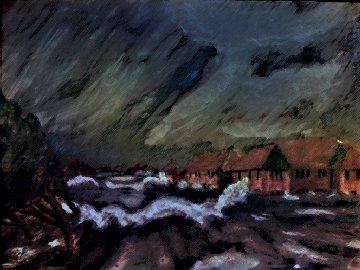 because of Joseph P. McCarthy, who played Jimmy Floyd. In one of the discussions about miners, Jimmy speaks up and says, "Miners are small and wiry like me." By wiry I think he meant feisty as well. I loved it when he showed off his first painting; the assigned topic was deluge. While Oliver painted a passionate storm scene, Jimmy painted a large yellow terrier in the center of the canvas that dwarfed every other element in the composition. There were many comments about the dog and what type it was. And then they asked Jimmy why the dog house was painted the same color green as the grass, he replied, "I ran out of brown." It worked for me.
because of Joseph P. McCarthy, who played Jimmy Floyd. In one of the discussions about miners, Jimmy speaks up and says, "Miners are small and wiry like me." By wiry I think he meant feisty as well. I loved it when he showed off his first painting; the assigned topic was deluge. While Oliver painted a passionate storm scene, Jimmy painted a large yellow terrier in the center of the canvas that dwarfed every other element in the composition. There were many comments about the dog and what type it was. And then they asked Jimmy why the dog house was painted the same color green as the grass, he replied, "I ran out of brown." It worked for me.
Later on when someone offered two pounds for his mate Oliver Kilbourn's painting, Jimmy asked if they wanted to buy any more (meaning his). A very practical artist.
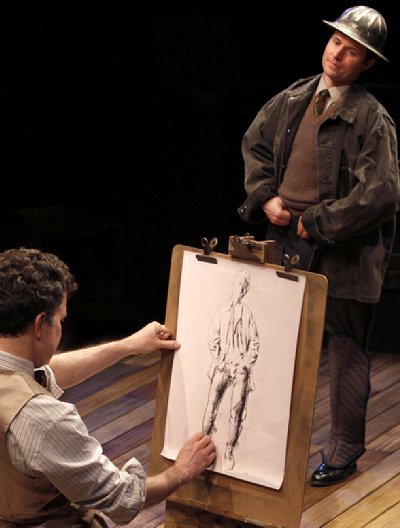 Later in the play, Robert Lyon sketches Oliver Kilbourn in 1890s miner's work clothes and then asked for Oliver's opinion. He got an honest opinion . . . a crushing indictment, unlike what Oliver would have given his fellow group members. Lyon created a genuine likeness, but it was void of feeling. Unfortunately, he only drew what was there in front of him. He brought nothing of himself or of the miner to the creation. The student had risen above his teacher.
Later in the play, Robert Lyon sketches Oliver Kilbourn in 1890s miner's work clothes and then asked for Oliver's opinion. He got an honest opinion . . . a crushing indictment, unlike what Oliver would have given his fellow group members. Lyon created a genuine likeness, but it was void of feeling. Unfortunately, he only drew what was there in front of him. He brought nothing of himself or of the miner to the creation. The student had risen above his teacher.
The play was written by Lee Hall, who was born in Newcastle Upon Tyne. He would have known people like these miners. He has extensive writing credits including the absolutely wonderful "Billy Elliot". The play was directed by Kurt Beattie, a long time artist of the Seattle theater scene from the heyday of the Empty Space. His production several years ago of "The Underpants" was pure hilarity. The wonderful bare wooden set, which screamed working class, was designed by set master Carey Wong.
The play is based on the book "The Pitmen Painters: Ashington Group, 1934-84" by art critic William Feaver. Their paintings were wonderful. But the ending of the play was like Oliver's commentary on Lyon's sketch. We're left with facts and figures, that the coal mines were nationalized into the National Coal Board and the Ashington mine closed, but no feelings and no passion. We saw the premier, so with all of the quality people involved in this production, ACT should be able to solve the ending. Perhaps, if they cut twenty minutes or so and get it down to two hours, it might help.
Throughout the play slides were shown of actual paintings as well as information about the group. These seemed to run on after the ending of the play, which may have added to the uncertainty at the end. But, then again there is always an uncertainty about art and perhaps that is what the ending was intended to mean.
The play runs thru May 20. Call the box office for tickets or information, or visit online at www.acttheatre.org.





